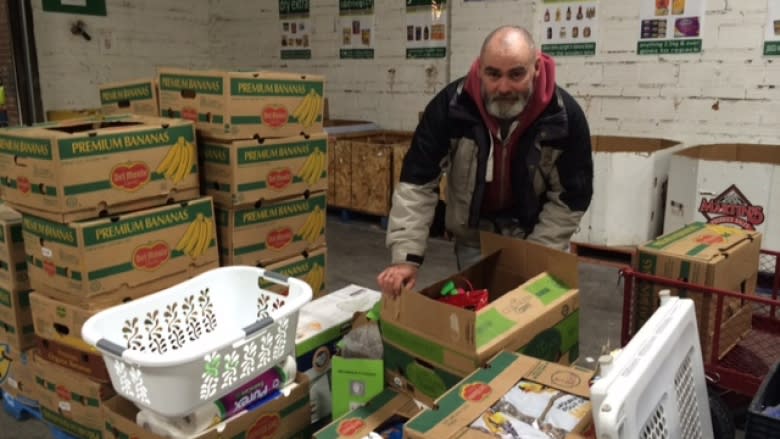Demand on Sask. food banks growing and widening
There was a time when Jarl Slind looked down on people who rely on the food bank — until he landed there himself.
"It really is a humbling experience," he said.
Slind is one of a growing category of food bank clients in Saskatchewan — people with jobs, who still can't make ends meet.
It took a chain of misfortune to propel him to the food bank's doorstep.
A smaller paycheque, for one thing. He gave up his big-money job in diamond drilling.
"My body is not as young and healthy as it used to be, I couldn't deal with the cold so much more", Slind explained.
Now he does factory work on the outskirts of Saskatoon.
Bills don't leave enough for food
He makes roughly $18.00 an hour — not quite double minimum wage. Enough to get by on, until trouble hit.
An alcoholic, he got into an uninsured auto collision the summer before last. He was sued and went bankrupt. Slind said he is still not off the financial hook for that, although he has sobered up.
Now 47 and single, a rented room for $525 a month is all Slind can afford.
With no bus service where he works, he still has to operate a vehicle.
So after all his monthly bills, there still isn't enough left over to properly feed himself. He's diabetic, and thinner than his doctor would like him to be.
Work lunches from food bank hamper
About a year ago he swallowed his pride and asked the food bank for help. Ever since, he has gone there twice a month — in the late afternoon after work — for an emergency supply.
Typically, it's a "couple loaves of bread, couple boxes of Kraft Dinner, a can of peas, maybe some hot dogs," he said. He uses it for lunches to take to work.
Even with that, he cuts corners in the kitchen. He no longer adds hamburger to his spaghetti sauce, for instance.
Although they'd like to, food banks around Saskatchewan aren't going out of business anytime soon.
Usage is up by 19 per cent across the province, from Mar. 2013 to Mar. 2014, according to Food Banks Canada.
An "unwelcome surprise" said Steve Compton, executive director of Food Banks of Saskatchewan.
Long-term trend
"We've certainly seen more families not necessarily keeping pace with the cost of living," Compton said.
It's part of a longer-term trend since the 2008 recession hit. Usage has vaulted by more than 50 per cent since then.
People on social assistance still make up the vast majority of food bank users (nearly 53 per cent this year, down from almost 56 per cent last year).
But nearly 15 per cent of food bank users have a job, edging up from around 14 per cent last year.
Compton and others who run food banks point to the rising cost of housing, utilities and food — while many peoples' incomes lag behind.
Rent hitting low-income people hard
For instance, the average rent for a two-bedroom non-subsidized apartment in Saskatoon has jumped by more than five per cent in the past year, according to the Canada Mortgage and Housing Corporation. Eight in ten food bank users are renters, and only a quarter of this group is living in subsidized housing, according to Food Banks Canada.
Spiralling rents have a disproportionate impact on people living in poverty, since they tend to spend two-thirds or more of their income on shelter and food, said Paul Gingrich, a member of Poverty Free Saskatchewan.
Vanessa Charles, a member of Saskatoon Anti-Poverty Coalition/Passion for Action Against Homelessness, remembers what it was like to cover non-subsidized rent on a social assistance income. She didn't use the food bank, but only because a small circle of friends gave her a gift certificate to a local grocery store every month.
"So that I was able to go out and get pieces of meat for instance, that I otherwise would have not been able to afford, or cheese and those kinds of extras," Charles said.
A move into subsidized seniors' housing has eased her own budget pressures. But Charles is aware of the struggles other people — even those with jobs — still go through.
"Unfortunately for people who are living on a minimum wage job, it's just not covering the cost of living at all," Charles observed.
According to the provincial government, the combined effect of tax cuts and minimum wage increases has raised the disposable incomes of full-time minimum wage earners 30 per cent in the last seven years.
But Gingrich has calculated that, within that same time period, the combined cost of food and shelter has gone up by 42 per cent.
"The earner at minimum wage is worse off now than in 2007", he said.
Need a 'living wage'
As Charles points out, the current $10.20 per hour minimum wage is still not a living wage, which the Canadian Centre for Policy Alternatives pegs at $16.46 an hour (for a Regina family with two parents working full-time and two children, ages four and seven). A "living wage" is what a household would have to earn to meet its basic needs.
Charles is heartened by the government's recent announcement that it's working on a poverty reduction strategy. She hopes it includes a living wage or guaranteed income for all people.
"Once people start having some kind of income that they can live on properly it makes differences in their lives," Charles explained. "Not just about the extra food that they have but in them feeling good about themselves."
That boost in self-esteem and confidence helps people go out and find jobs or improve their lives in other ways, Charles added.
Meanwhile, food banks across the province are striving to keep pace with the rising demand.
"You're always concerned about sustaining the very basic things you do," said Compton.
Jarl Slind can attest to the strain.
"Some days I go in there, the lineup is out the door, in the summertime it was out the door," he said.
There are pieces of good news. For the past year the food banks have been receiving donations of food and hygiene products — such as toilet paper and toothpaste — from the Loblaws warehouse in Regina. The non-perishables may be damaged packages, surplus shipments or leftovers from time-sensitive promotions. It's a valuable contribution because money saved on toiletries and cleaning products can be redirected toward food purchases.
But Compton still worries about donor and volunteer fatigue. He estimates about three-quarters of the labour in food banks is done by volunteers.
He'd like to see the day when they won't have to be called upon anymore.
"Food banks are an industry that would be happy to fade away," Compton said.
But that won't happen until poverty itself fades away. And that will take the combined effort of helping agencies, business and government, Compton concluded.




